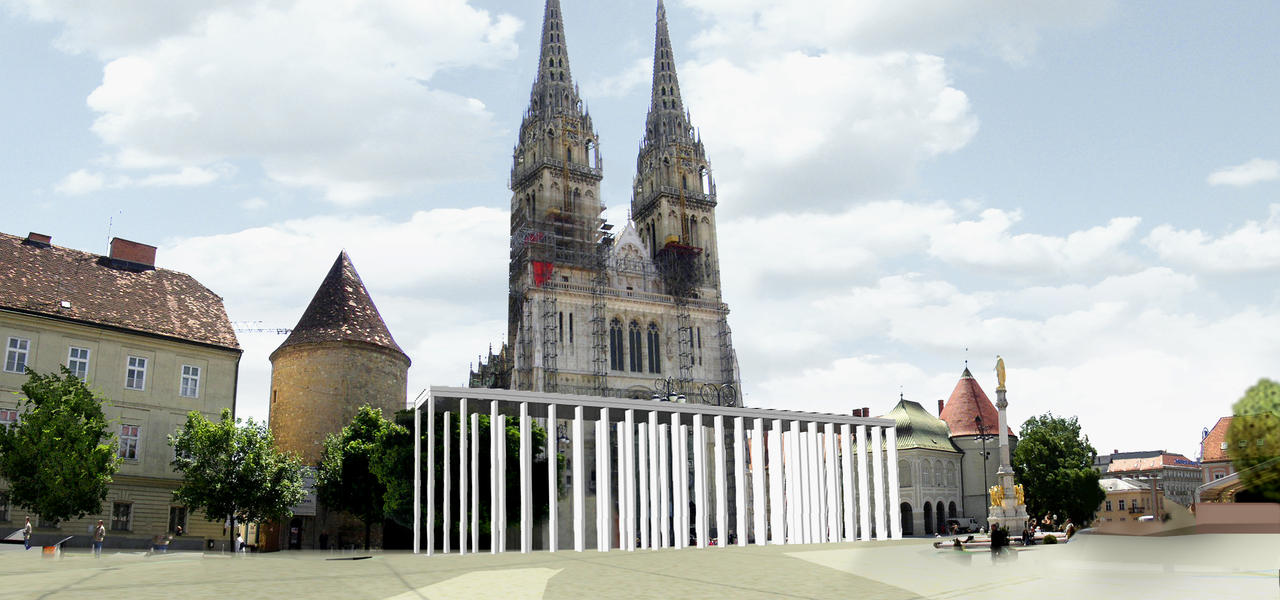
Transformation of Kaptol
Status:
Project not implemented
Year of designing:
2008.
Program:
Competition, Urbanism
Location:
Kaptol,
show location on map
Authors:
Borko Zugan, Tomislav Štivić, Vladi Bralić
Associates:
Aniko Budai, Arsen Čupev, Vedrana Ljubić, Vladimir Čavar
The Episcopal headquarters with the cathedral and the kaptol (of the Zagreb Archdiocese) was since its beginning located where it is today, on Kaptol hill where, according to old authors, a castrum was located; and on the neighboring hill, Gradec, west from the stream of Medveščak (today Tkalčićeva ulica / Tkalčić’s Street), the citizens have determined a free and royal city of Gradec.
On the Kaptol hill a cathedral was being made, on and off, until the end of 15th century. Soon after, the city needed to be protected against the Turks. This is why the building of the first defensive system around the cathedral has begun. On the eastern side, the protection was found in the swamps (today, Ribnjak). At the same time, the priests were erecting walls and towers around the Kaptol hill, some of which have remained until today, either standing apart or integrated in today’s buildings. Building walls around Kaptol was followed by an intense social and urban change: by the western wall a street (Opatovina) was drawn out and people have been called to populate it in order of magnifying their number so that they can eventually defend Kaptol. In later stages the population has slowly grown in number, especially on the feet of the hills so three old jurisdictions were (Bishop, Kaptol and Gradec jurisdictions) joined in constituting a free city of Zagreb. Further growth witnessed the destruction of the old city portal and of parts of the defending buildings, and the swampy ground which had served as defense by water has been decorated into a fishpond and later, with silting, into a promenade park.
Newer times have as well witnessed a radical reconstruction of the cathedral, building of the city piazza, followed by a series of short and intensive traffic adaptations; all this profoundly influenced the formal and structural changing of Kaptol as nuclear to city of Zagreb. However, regardless of the historical transformations, Kaptol has remained until today, the nucleus of Zagreb, in the cultural, historical, spiritual, social and jurisdictive sense.
The concept of this solution (competition work) in the urban sense suggests:
- For Kaptol to exceed its current, semantic level of significance (Headquarters of Croatia’s Catholic Church) by underlining the modern features it represents for Zagreb: the Kaptol Hill and the waters on the foot of it;
- To finalize the architectural composition of Kaptol Square, a space of great value to the history of the city, the church and the people. This space should extend to the western public square (Forum Populi) and to the eastern vestibule in front of the cathedral (Atrium Ecclesiae);
- To relocate the new buildings of Kaptol: Treasury of the Zagreb Cathedral, Archbishop Archive of Old Kaptol of Zagreb and the Diocese museum. These buildings should not serve to hide the basic identity of this place which is medieval spatial composition. The later is exemplified in Kaptol’s curie, its gardens and the long church towers stretching behind them;
- To plan the area of Kaptol according to the balance and harmony of sacral and profane buildings, so that Dolac and Opatovina may host new buildings of representative and worldly purpose;
- To plan the area of Kaptol as a completely pedestrian zone with severely reduced motor traffic, possible only for the local residents;
- To plan a new regulation of the city area Dolac which intertwines with Kaptol into an inextricable spatial entirety?
Other projects from the category Urbanism:
- Hotel Potok
- Strmica Water Tower
- Park Pomerio
- Maritime Faculty in Rijeka
- Residential Towers See Mar
- Theatre Park
- Sava Park, Remetinec and Tromostovlje
- West Coast of Split
- Fountain Square in Buzet
- Civitas Novae and Porto Baroš
- Pula Waterfront



